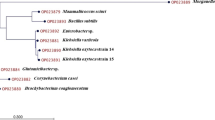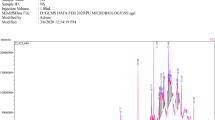Abstract
Insects harbor bacteria that are a rich source of enzymes that can be utilized for various industrial and biotechnological applications. It is predicted that during evolution these detoxifying enzymes have been acquired by insects through bacteria. However, the role of host insect detoxification enzymes has already been extensively studied but only a few resistance development studies have been focused on the enzymes derived from gut bacteria. Thus in this study, two bacterial isolates were found in the gut of Chironomous circumdatus larvae having esterase activity, out of which one bacterium was molecular characterized and it was found to be Enterobacter mori designated as strain BI1245. Further, crude extract from the bacterium was characterized and it was observed that it showed maximum activity at pH 8 and temperature 60 °C. Moreover, the crude extract showed 0.26 mM and 290 U/mg of protein as Km and Vmax value when p-nitrophenyl acetate was used as a substrate. Thereafter, the bacterial isolate was incubated in minimal salts medium containing modified phthalates and it was found that bacterium could utilize shorter alkyl-chain phthalic acid esters faster as compared to long alkyl chains thereby indicating that side chain of the substrates has a significant effect on the utilization of phthalic acid esters. Thus the gut flora present in insects may play an important role in providing resistance to the host to live in phthalate polluted water.





Similar content being viewed by others
Data Availability
All the data generated or analyzed during this study is provided in the manuscript and its associated materials.
References
Shapira M (2016) Gut microbiotas and host evolution: scaling up symbiosis. Trends Ecol Evol. https://doi.org/10.1016/j.tree.2016.03.006
Ng F, Willner L, Lim W, Schmieder R, Chau B, Nilsson C, Anthony S, Ruan Y, Rohwer F, Breitbart M (2011) Broad surveys of DNA viral diversity obtained through viral metagenomics of mosquitoes. PLoS ONE 6:e20579. https://doi.org/10.1371/journal.pone.0020579
Gendrin M, Christophides K (2013) The Anopheles mosquito microbiota and their impact on pathogen transmission. Anopheles Mosquitoes - New Insights into Malaria Vectors. https://doi.org/10.5772/55107
Clark M, Nancy A, Moran N, Baumann P, Wernegreen J (2000) Cospeciation between bacterial endo-symbionts (Buchnera) and a recent radiation of aphids (Uroleu-con) and pitfalls of testing for phylogenetic congruence. Evolution 54:517–525. https://doi.org/10.1111/j.0014-3820.2000.tb00054
Molinari F, Brenna O, Valenti M, Aragozzini F (1996) Isolation of a novel carboxylesterase from Bacillus coagulans with high enantioselectivity toward racemic esters of 1,2- Oisopropylideneglycerol. Enzyme Microb Tech 19:551–556. https://doi.org/10.1016/S0141-0229(96)00066-X
Kulkarni S, Patil S, Satpute S (2013) Microbial esterases: an overview. Int J Curr Microbiol App Sci 2(7):135–146
Bornscheuer U (2002) Microbial carboxyl esterases: classification, properties, and application in biocatalysis. FEMS Microbiol Rev 26:73–81. https://doi.org/10.1111/j.1574-6976.2002.tb00599.x
Sogorb M, Vilanova E (2002) Enzymes involved in the detoxification of organophosphorus, carbamate, and pyrethroid insecticides through hydrolysis. Toxicol Lett 128:215–228. https://doi.org/10.1016/s0378-4274(01)00543-4.x
Cartwright C, Owen S, Thompson I, Burns R (2000) Biodegradation of Diethyl phthalate by a soil bacterium. Curr Micro 11:321–324. https://doi.org/10.1111/j.1574-6968.2000.tb09077.x
Li X, Schuler M, Berenbaum M (2007) Molecular mechanisms of metabolic resistance to synthetic and natural xenobiotics. Ann Rev Entomol 52:231–253. https://doi.org/10.1146/annurev.ento.51.110104.151104
Armitage P, Cranston S, Pinder V (1995) The chironomidae: the biology and ecology of non-biting midges. Chapman & Hall; ISBN-13: 978-0412452604
Ramprasad K, Thiyagarajan S, Puneeth K, Sreenath P, Ravi N, Tha T, Gopireddy V, Subba R (2017) Bacterial fauna associating with chironomid larvae from lakes of Bengaluru city, India - A 16s rRNA gene-based identification. Genomics Data 12:44–48. https://doi.org/10.1016/j.gdata.2017.03.001
Kumar D, Ramesh U (2014) Rearing practices of live feedstuff animal midge fly larvae (Chironomus circumdatus) Kieffer (Diptera: Chironomidae). Int J curr Sci 12:170–177
Suoniemi A, Tynkkynen S (2002) Cloning and characterization of an esterase from Propionibacteriom feudenreichii ssp. Shermanii Lait 82:81–89
Heuer H, Krsek M, Baker P, Smalla K, Wellington M (1997) Analysis of actinomycete communities by specific amplification of genes encoding 16S rRNA and gel-electrophoretic separation in denaturing gradients. Appl Environ Microbiol 63:3233–3241
Nawani N, Kaur J (2000) Purification, characterization and thermostability of a lipase from a thermophilic Bacillus sp. J33. Mol Cell Biochem 206:91–96. https://doi.org/10.1023/a:1007047328301
Prathibha K, Sumathi S (2008) Biodegradation of mixture containing monohydroxybenzoate isomers by Acinetobacter calcoaceticus. World J Microbial Biotechnol 24:813–823. https://doi.org/10.1007/s11274-007-9545-x
Lowry H, Rosebrough J, Farr L, Randall J (1951) Protein measurement with the folin phenol reagent. J Biol Chem 193:265–275
Xu S, Komatsu C, Takahashi I, Suye S (2006) Purification and properties of diethyl p-phthalate esters from Ochrobactrum anthropic 6–2b. Fiber 62(10):226–231. https://doi.org/10.2115/fiber.62.226
Lineweaver H, Burk D (1934) The determination of enzyme dissociation constant. J Am Chem Soc 56:658–661. https://doi.org/10.1021/ja01318a036
Mohan V, Shailaja S, Krishna R, Reddy B, Sarma N (2006) Bioslurry phase degradation of di-ethyl phthalate (DEP) contaminated soil in periodic discontinuous mode operation: influence of bioaugmentation and substrate partition [J]. Process Biochem 4(3):644–652. https://doi.org/10.1016/j.procbio.2005.08.018
Sarfraz M, Dosdall LM, Keddie BA (2006) Diamondback moth-host plant interactions: implications for pest management. Crop Prot 25:625–639. https://doi.org/10.1016/j.cropro.2005.09.011
Vuilleumier S (1997) Bacteria glutathione S-transferase: what are they good for? J Bacteriol 179:1431–1441. https://doi.org/10.1128/jb.179.5.1431-1441.1997
Baek H, Kim I, Lee W, Chung K, Miyata T, Lee H (2005) Identification and characterization of ace- 1-type acetylcholinesterase likely associated with organophosphate resistance in Plutella xylostella. Pest Biochem Physiol 81:164–175. https://doi.org/10.1016/j.pestbp.2004.12.003
Boush M, Matsumura F (1967) Insecticidal degradation by Pseudomonas melophthora, the bacterial symbiote of the apple maggot. J Econ Entomol 60:918–920. https://doi.org/10.1093/jee/60.4.918
Montella R, Martins J, Viana-Medeiros F, Lima B, Braga A, Valle D (2007) Insecticide resistance mechanisms of Brazilian Aedes aegypti populations from 2001 to 2004. Am J Trop Med Hyg 77:467–477
Hotta Y, Ezaki S, Atomi H, Imanaka T (2002) Extremely stable and versatile carboxylesterase from a hyperthermophilic archaeon. Appl Environ Microb 68:3925–3931. https://doi.org/10.1128/aem.68.8.3925-3931.2002
Suoniemi A, Tynkkynen S (2002) Cloning and characterization of an esterase from Propionibacteriom feudenreichii ssp. Shermanii. Lait Dairy Sci Technol 82(1):81–89. https://doi.org/10.1051/lait:200100
Kademi A, Ait- Abdelkader N, Fakhreddine L, Baratti C (2000) Purification and characterization of a thermostable esterase from the moderate thermophilic bacterium Bacillus circulans. Appl Microbiol Biot 54:173–179. https://doi.org/10.1007/s002530000353
Teo P, Zhang L, Poh L (2003) Cloning and characterization of a novel lipase from Vibrio harveyi strain AP6. Gene 312:181–188. https://doi.org/10.1016/S0378-1119(03)00615-2
Ozlem F, Ahmet C, Nagihan S, Sabriye C, Ali B (2007) Determination and characterization of thermostable esterolytic activity from a novel thermophilic bacterium Anoxybacillus gonensis A4. J Biochem Mol Biol 40(4):588–594. https://doi.org/10.5483/BMBRep.2007.40.4.588
Kademi A, Ait- AN, Fakhreddine L, Baratti C (1999) A thermostable esterase activity from newly isolated moderate thermophilic bacterial strains. Enzyme Microb Tech 24:332–338. https://doi.org/10.1016/S0141-0229(98)00127-6
Lee D, Koh Y, Kim K, Kim B, Choi H, Kim D, Suhartono MT, Pyun Y (1999) Isolation and characterization of a thermophilic lipase from Bacillus thermoleovorans ID. FEMS Microbiol Lett 179:393–400. https://doi.org/10.1111/j.1574-6968.1999.tb08754.x
Colak A, Pipik D, Saglam N, Guner S, Canakci S, Belduz A (2005) Characterization of a thermoalkalophilic esterase from a novel thermophilic bacterium, Anoxybacillus gonensis G2. Bioresource Technol 96:625–631. https://doi.org/10.1016/j.biortech.2004.06.003
Bradoo S, Saxena RK, Gupta R (1999) Two acidothermotolerant lipases from new variants of Bacillus spp. World J Microb Biot 15:97–102
Chang B, Yang C, Cheng H, Yuan S (2004) Biodegradation of phthalate esters by two bacteria strains. Chemosphere 55(4):533–538. https://doi.org/10.1016/j.chemosphere.2003.11.057
Vega D, Bastide J (2003) Dimethyl phthalate hydrolysis by specific microbial esterase. Chemosphere 51:663–668. https://doi.org/10.1016/S0045-6535(03)00035-3
Liang D, Zhang T, He J (2008) Phthalates biodegradation in the environment. Appl Microbiol Biotechnol 80(2):183–198. https://doi.org/10.1007/s00253-008-1548-5
Vamsee-Krishna C, Mohan Y, Phale S (2006) Biodegradation of phthalate isomers by Pseudomonas aeruginosa PP4, Pseudomonas sp PPD, and Acinetobacter lwoffii ISP4. Appl Microbiol Biotechnol 72(6):1263–1269. https://doi.org/10.1007/s00253-006-0413-7
Liang R, Wu X, Wang X, Dai Q, Wang Y (2010) Aerobic biodegradation of diethyl phthalate by Acinetobacter sp. JDC-16 isolated from river sludge. J Cent South Univ Technol 17:959–966. https://doi.org/10.1007/s11771−010−0584−3
Li J, Gu J, Pan L (2005) Transformation of dimethyl phthalate, dimethyl isophthalate, and dimethyl terephthalate by Rhodococcus rubber Sa and modeling the processes using the modified Gompertz model. Int Biodeterior Biodegradation 55(3):223–232. https://doi.org/10.1016/j.ibiod.2004.12.003
Acknowledgements
The authors are thankful to the Department of Zoology, Savitribai Phule Pune University for providing the infrastructure for carrying out the research work. Authors are also thankful to Dr. Praveen Rahi (National Centre for Microbial Resource, National Center for Cell Science) for his valuable suggestions and to Ms. Priya Jadhav and Mr. Kiran Choudaj for helping in the collection of Chironomus circumdatus larvae. The research work was supported by the University Grant Commission (UGC)-Centre for Advanced Studies (Phase 3) (2019–2020) and Council of Scientific and Industrial Research (CSIR). The funding sources had no role in design, execution and publication of this study.
Funding
The research work was supported by the University Grant Commission (UGC)-Centre for Advanced Studies (Phase 3) (2019–2020) and Council of Scientific and Industrial Research (CSIR). No financial help was provided for publishing this article.
Author information
Authors and Affiliations
Contributions
Conceptualization: CMS, formal analysis: CMS, investigation: CMS, writing-original draft preparation: CMS, writing-review and editing: RSP, supervision: RSP. All authors have read and agreed to the published version of the manuscript.
Corresponding author
Ethics declarations
Conflict of interest
The authors declare that they have no conflict of interest.
Ethical Approval
This article does not contain any studies with human participants or animals performed by any of the authors.
Additional information
Publisher's Note
Springer Nature remains neutral with regard to jurisdictional claims in published maps and institutional affiliations.
Rights and permissions
About this article
Cite this article
Shaha, C.M., Pandit, R.S. Characterization of an Esterase Producing Bacterium from the Gut of Chironomus circumdatus (Bloodworms) and its Ability to Use Modified Phthalates. Curr Microbiol 78, 3165–3172 (2021). https://doi.org/10.1007/s00284-021-02574-x
Received:
Accepted:
Published:
Issue Date:
DOI: https://doi.org/10.1007/s00284-021-02574-x




